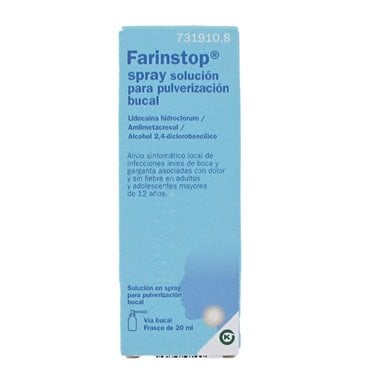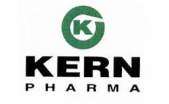Farinstop Spray Solution For Mouth Spraying 20 Ml
Farinstop spray contains amylmetacresol and 2,4-dichlorobenzyl alcohol, both antiseptics, and lidocaine hydrochloride monohydrate, a local anesthetic for the throat. It is indicated for the local symptomatic relief of mild infections of the mouth and throat associated with pain and without fever in adults and adolescents over 12 years of age.
Farinstop spray contains amylmetacresol and 2,4-dichlorobenzyl alcohol, both antiseptics, and lidocaine hydrochloride monohydrate, a local anesthetic for the throat. It is indicated for the local symptomatic relief of mild infections of the mouth and throat associated with pain and without fever in adults and adolescents over 12 years of age.
Farinstop Spray Solution For Mouth Spraying 20 Ml
INDICATIONS
- Local symptomatic relief of mild [ORAL INFECTION] and sore throat, associated with pain and without fever, in adults and adolescents over 12 years of age.
POSOLOGY
- Adults and adolescents > 15 years: 2 pulsations in the mouth and/or throat from 1 to 6 times a day.
- Children and adolescents from 12 to 15 years old: 2 pulsations in the mouth and/or throat 1 to 4 times a day.
- Children and adolescents < 12 years: should not be used in this population.
- Elderly: does not require dose readjustment.
DOSAGE IN RENAL FAILURE
No specific dosage recommendations have been made.
DOSAGE IN LIVER FAILURE
No specific dosage recommendations have been made.
RULES FOR CORRECT ADMINISTRATION
- Administration by oral route.
Administration with food: do not take before meals or drinks.
CONTRAINDICATIONS
- Hypersensitivity to any component of the drug.
PRECAUTIONS
- Not recommended for children under 12 years of age.
- High doses or an increase in frequency can affect the nervous system and can cause [SEIZURES] or affect the heart. Do not use for more than 5 days.
- Caution in seriously ill or frail elderly patients.
- The anesthesia of the throat caused by this medicine can cause pulmonary aspiration (coughing when eating, producing a sensation of suffocation). It should not be taken before food or drink.
- Caution in patients with [ASTHMA]. Use under medical supervision.
- Numbness of the tongue may occur and increase the risk of trauma from bites. Caution when eating and drinking hot food. Swallowing may be affected and therefore increase the risk of aspiration.
ADVICE TO THE PATIENT
- Make sure you are adequately familiar with the rules of administration of this medicine before its use. Consult the pharmacist if necessary.
- Check with your doctor and/or pharmacist if the symptoms continue or worsen during treatment.
- Inform your doctor if you are pregnant, think you may be or plan to become pregnant before starting treatment.
- Inform your doctor if you are lactating before starting treatment.
- This medication is susceptible to interactions. Inform your doctor or pharmacist of all medications, food supplements and/or herbs that you are taking.
SPECIAL WARNINGS
- Do not use for more than 5 days. If the symptoms persist for more than 3 days, worsen or other symptoms appear, it is recommended to consult a health professional.
INTERACTIONS
- Other antiseptics: possibility of appearance of antagonism. Do not use together.
- Beta-adrenergic blockers and cimetidine: they can reduce the rate of metabolism of lidocaine and increase its toxicity.
- Class II antiarrhythmics.
PREGNANCY
Safety in animals: insufficient studies
Safety in humans: studies have indicated that there is no increased risk of birth defects after the use of lidocaine, even though it crosses the placenta. There are no adequate and well-controlled studies in humans for amylmetacresol and 2,4-dichlorobenzyl alcohol. As a precautionary measure, it is recommended to avoid its use.
Effects on Fertility: No specific studies have been conducted in humans.
LACTATION
Excretion in Milk: Lidocaine is excreted in small amounts in breast milk. There are no data on the excretion of amylmetacresol and 2,4-dichlorobenzyl alcohol in breast milk.
Safety in animals: no data available.
Safety in humans: its safety has not been established. A risk to nursing infants cannot be excluded. A decision should be made whether to discontinue breast-feeding or to interrupt/suspend treatment after considering the benefit of breast-feeding for the child and the benefit of treatment for the mother.
CHILDREN
It can be used in children or adolescents from 15 years of age, at the same doses as in adults.
It can be used in children or adolescents from 12 to 15 years old, with the corresponding dosage adjustment (see Dosage).
It should not be used in children and adolescents under 12 years of age.
ADVANCED AGE
No specific problems have been described in the elderly that require a dose readjustment.
EFFECTS ON DRIVING
The influence on the ability to drive and use machines is null or negligible.
ADVERSE REACTIONS
Adverse reactions are described according to each frequency interval, being considered very common (>10%), common (1-10%), uncommon (0.1-1%), rare (0.01-0.1%), very rare (<0.01%) or unknown frequency (cannot be estimated from the available data).
- Immune system disorders: rare [HYPERSENSITIVITY REACTIONS] (burning, itching), symptoms of [SYNCOPE], [ANGIOEDEMA], itchy throat and unpleasant taste.
- Gastrointestinal disorders: very rare gastrointestinal disorders.
OVERDOSE
Symptoms: problems related to overdose are not expected. In case of systemic absorption, transient CNS stimulation may occur, followed by CNS depression and depression of the cardiovascular system. Prolonged use for more than 5 days may upset the natural microbial balance in the throat. Use in children under 6 years of age at high doses and for long periods of time can cause seizures. Excessive anesthesia of the upper respiratory and digestive tracts may occur.
Measures to take:
- Antidote: there is no specific antidote.
- General elimination measures: induction of vomiting and/or gastric lavage can be considered within one hour, in case of potentially serious poisoning.
- Monitoring: no special measures have been described.
- Treatment: symptomatic.



